Study on the Factors Influencing the Amplitude of Local Ice Pressure on Vertical Structures Based on Model Tests
Abstract
:1. Introduction
2. Model Tests
2.1. Sea Ice Loading Model Test
- Model Ice Preparation: To obtain low-strength sea ice that meets the experimental requirements, high-salinity seawater was prepared using sea salt within the loading device. The ice sheet froze from top to bottom, forming columnar ice. The laboratory temperature was set to −20 °C for rapid freezing, followed by a temperature recovery process to control the internal temperature of the sea ice.
- Sensor Installation: After calibrating thin-film pressure transducer, they are installed on the model structure.
- Test Loading: Different loading speeds are set, and the support platform pushes the sea ice at the corresponding speed to interact with the vertical steel plate (vertical structure model). Loading continues to a specific displacement before automatic unloading and returning to the initial position.
- Data Extraction: Using imaging software and a MATLAB-based data processing program (MATLAB R2021a (9.10)), the experimental data were processed to obtain time-history graphs of local and overall ice forces at each moment. The peak points of each force measurement unit were extracted, and the relevant data were exported.
2.2. Test Data
3. Study on Factors Influencing Local Ice Pressure Amplitude
3.1. Analysis of the Timing of Local Ice Pressure Occurrence
3.2. Influence of Loading Speed on Local Ice Pressure Amplitude
3.3. Influence of Ice Thickness on Local Ice Pressure Amplitude
4. Study on the Influencing Factors of Local Ice Pressure–Area Relationship
4.1. Local Area Calculation
4.2. Factors Affecting the Local Ice Pressure–Area Relationship
4.3. Distribution Pattern of Local Ice Pressure–Area Curve Coefficients
5. Discussion
6. Conclusions
Author Contributions
Funding
Institutional Review Board Statement
Informed Consent Statement
Data Availability Statement
Conflicts of Interest
References
- Kim, H.; Ulan-Kvitberg, C.; Daley, C. Evaluation of spatial pressure distribution during ice-structure interaction using pressure indicating film. Int. J. Nav. Archit. Ocean Eng. 2014, 6, 578–597. [Google Scholar] [CrossRef]
- Jordaan, I.; Li, C.; Sudom, D.; Stuckey, P.; Ralph, F. Principles for local and global ice design using pressure-area relationships. In Proceedings of the 18th International Conference on Port and Ocean Engineering Under Arctic Conditions, Potsdam, NY, USA, 26–30 June 2005; Volume 1, pp. 375–386. [Google Scholar]
- Jordaan, I.J.J.C.R.S. Mechanics of ice–structure interaction. Eng. Fract. Mech. 2001, 68, 1923–1960. [Google Scholar] [CrossRef]
- Taylor, R.; Frederking, R.; Jordaan, I. The nature of high pressure zones in compressive ice failure. In Proceedings of the 19th International Symposium on Ice, Vancouver; IAHR: Beijing, China, 2008; pp. 1001–1010. [Google Scholar]
- Frederking, R. Ice pressure variations during indentation. In Proceedings of the International Association of Hydraulic Research Symposium on Ice, Saint Petersburg, Russia, 21–25 June 2004. [Google Scholar]
- Riska, K.; Rantala, H.; Joensuu, A. Full Scale Observations on Ship-Ice Contact Results from Tests Series Onboard IB Sampo, Winter 1989; Report M-97; Helsinki University of Technology, Laboratory of Naval Architecture and Marine Engineering: Espoo, Finland, 1990. [Google Scholar]
- Timco, G.; Sudom, D. Revisiting the Sanderson pressure–area curve: Defining parameters that influence ice pressure. Cold Reg. Sci. Technol. 2013, 95, 53–66. [Google Scholar] [CrossRef]
- Frederking, R.; Timco, G.; Wright, B. Ice Pressure Distributions from First-Year Sea Ice Features Interacting with the Molikpaq in the Beaufort Sea. In Proceedings of the The Ninth International Offshore and Polar Engineering Conference, Brest, France, 30 May–4 June 1999. [Google Scholar]
- Masterson, D.M.; Frederking, R.M.W. Local contact pressures in ship/ice and structure/ice interactions. Cold Reg. Sci. Technol. 1993, 21, 169–185. [Google Scholar] [CrossRef]
- Masterson, D.; Frederking, R.; Wright, B.; Kärnä, T.; Maddock, W.P. A Revised Ice Pressure-Area Curve. In Proceedings of the 19th International Conference on Port and Ocean Engineering under Arctic Conditions, Dalian, China, 27–30 June 2007. [Google Scholar]
- Sanderson, T.J. Ice Mechanics and Risks to Offshore Structures; Graham & Trotman: Barnet, UK, 1988. [Google Scholar]
- Kärnä, T.; Qu, Y.; Yue, Q. An Extreme Value Analysis of Local Ice Pressures. In SNAME International Conference and Exhibition on Performance of Ships and Structures in Ice; SNAME: Attica, Greece, 2006. [Google Scholar]
- Wells, J.; Jordaan, I.; Derradji-Aouat, A.; Taylor, R. Small-scale laboratory experiments on the indentation failure of polycrystalline ice in compression: Main results and pressure distribution. Cold Reg. Sci. Technol. 2011, 65, 314–325. [Google Scholar] [CrossRef]
- Kuutti, J.; Kolari, K.; Marjavaara, P. Simulation of ice crushing experiments with cohesive surface methodology. Cold Reg. Sci. Technol. 2013, 92, 17–28. [Google Scholar] [CrossRef]
- Sodhi, D.S. Crushing failure during ice–structure interaction. Eng. Fract. Mech. 2001, 68, 1889–1921. [Google Scholar] [CrossRef]
- Palmer, A.C.; Dempsey, J.P.; Masterson, D.M. A revised ice pressure-area curve and a fracture mechanics explanation. Cold Reg. Sci. Technol. 2009, 56, 73–76. [Google Scholar] [CrossRef]
- Su, B.; Riska, K.; Moan, T. Numerical simulation of local ice loads in uniform and randomly varying ice conditions. Cold Reg. Sci. Technol. 2011, 65, 145–159. [Google Scholar] [CrossRef]
- Taylor, R.S.; Richard, M.; Hossain, R. A probabilistic high-pressure zone model for local and global loads during ice-structure interactions. J. Offshore Mech. Arct. Eng. 2019, 141, 051604. [Google Scholar] [CrossRef]
- Shamaei, F.; Bergström, M.; Li, F.; Taylor, R.; Kujala, P. Local pressures for ships in ice: Probabilistic analysis of full-scale line-load data. Mar. Struct. 2020, 74, 102822. [Google Scholar] [CrossRef]
- Long, X.; Liu, L.; Liu, S.W.; Ji, S. Discrete Element Analysis of High-Pressure Zones of Sea Ice on Vertical Structures. J. Mar. Sci. Eng. 2021, 9, 348. [Google Scholar] [CrossRef]
- Wang, G.; Yue, Q.; Zhang, D.; Fu, Y.; Peng, X.; Dong, R. Distribution analysis of local ice pressures in the indentation test at various velocities. J. Mar. Sci. Eng. 2022, 10, 433. [Google Scholar] [CrossRef]
- Zhao, W.D.; Leira, B.J.; Hoyland, K.V.; Kim, E.; Feng, G.; Ren, H. A Framework for Structural Analysis of Icebreakers during Ramming of First-Year Ice Ridges. J. Mar. Sci. Eng. 2024, 12, 611. [Google Scholar] [CrossRef]
- International Organization for Standardization. Petroleum and Natural Gas Industries: Arctic Offshore Structures; Canadian Standards Association: Toronto, ON, Canada, 2020. [Google Scholar]
- Rong, L.; Jiao, J. Computational Fluid Dynamics (CFD)-Finite Element Analysis (FEM)-Discrete Element Method (DEM) Simulation Method for Flow-Fixing Coupling of Ships Sailing in Ice Areas. CN 115081349-A, 12 May 2022. [Google Scholar]
- He, S.; Chen, X.; Cui, H.; Ji, S. A study on ice induced vibration of a ship structure based on full scale measurement. J. Vib. Shock 2023, 42, 319–326. [Google Scholar]
- Lemström, I.; Polojärvi, A.; Puolakka, O.; Tuhkuri, J. Load distributions in the ice-structure interaction process in shallow water. Ocean Eng. 2022, 258, 111730. [Google Scholar] [CrossRef]
- Wang, C.; Gong, J.J.; Zhang, Y.; Liu, L.; Lou, M. Investigating Load Calculation for Broken Ice and Cylindrical Structures Using the Discrete Element Method. J. Mar. Sci. Eng. 2024, 12, 395. [Google Scholar] [CrossRef]
- Liu, L.; Yin, Z.; Ji, S. High-performance dilated polyhedral based DEM for ice loads on ship and offshore platform structures. Chinese. J. Theor. Appl. Mech. 2019, 51, 1720–1739. [Google Scholar]
- Erceg, S.; Erceg, B.; Polach, F.V.U.; Ehlers, S. A simulation approach for local ice loads on ship structures in level ice. Mar. Struct. 2022, 81, 103117. [Google Scholar] [CrossRef]
- Johnston, M.; Croasdale, K.R.; Jordaan, I.J. Localized pressures during ice–structure interaction: Relevance to design criteria. Cold Reg. Sci. Technol. 1998, 27, 105–117. [Google Scholar] [CrossRef]
- Daley, C. A Study of the Process-Spatial Link in Ice Pressure-Area Relationships; PERD, Memorial University of Newfoundland: St. John, NL, Canada, 2004. [Google Scholar]
- Kim, H.; Daley, C.; Ulan-Kvitberg, C. Reappraisal of Pressure Distribution Induced by Ice-Structure Interaction using High-precision Pressure Measurement Film. In SNAME International Conference and Exhibition on Performance of Ships and Structures in Ice; SNAME: Attica, Greece, 2012. [Google Scholar]
Disclaimer/Publisher’s Note: The statements, opinions, and data contained in all publications are solely those of the individual author(s) and contributor(s) and not of MDPI and/or the editor(s). MDPI and/or the editor(s) disclaim responsibility for any injury to people or property resulting from any ideas, methods, instructions, or products referred to in the content. |
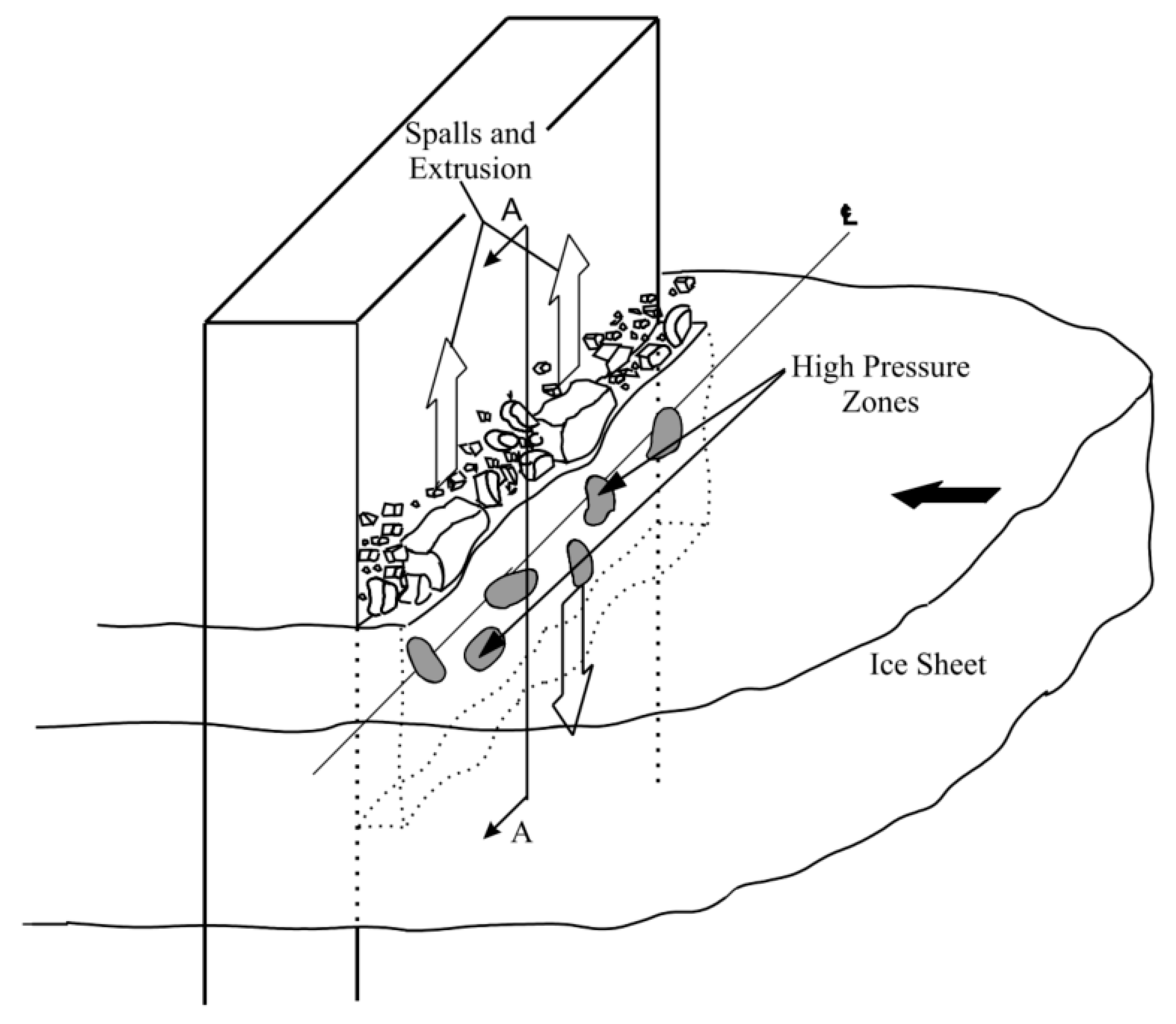

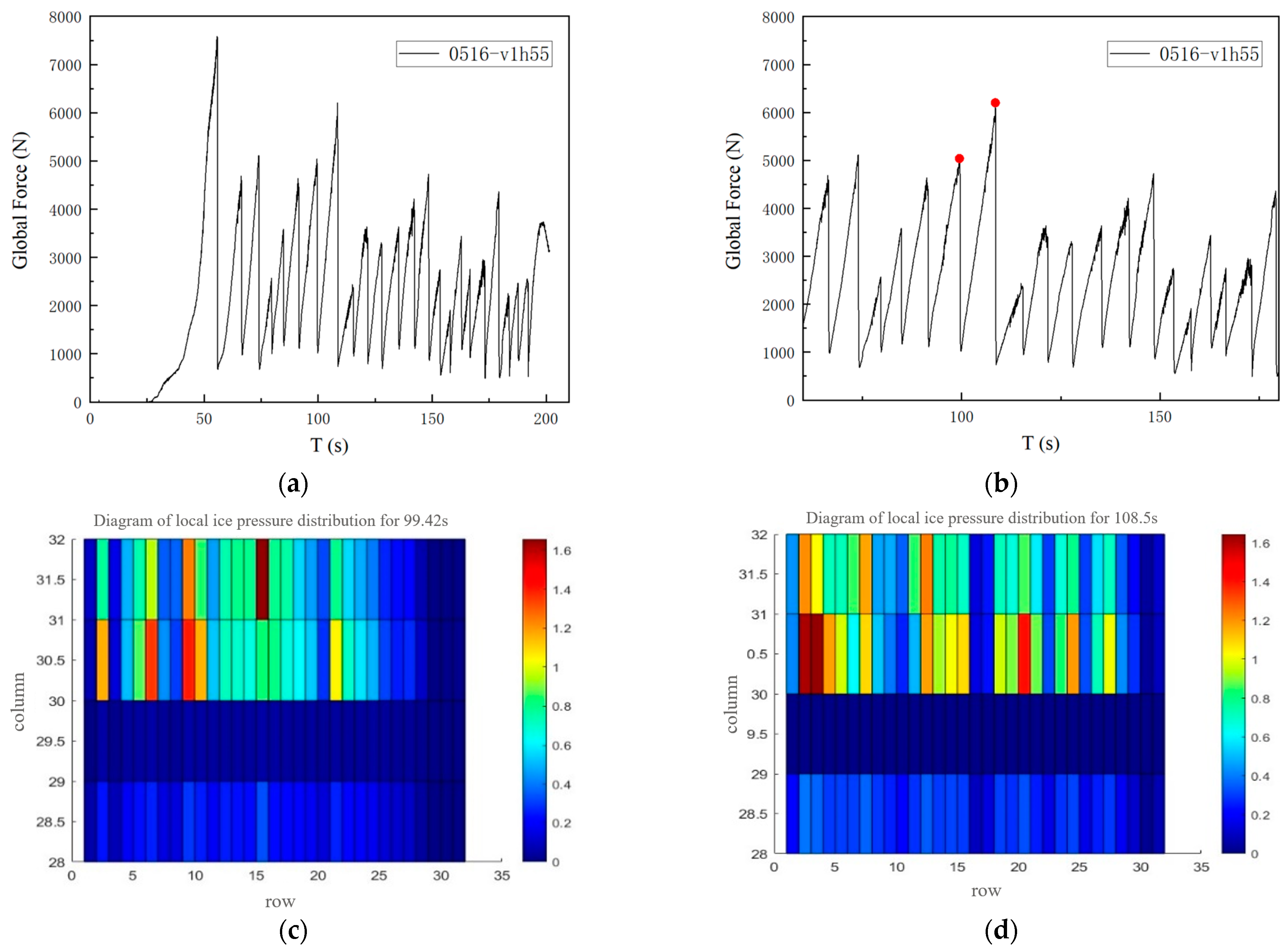

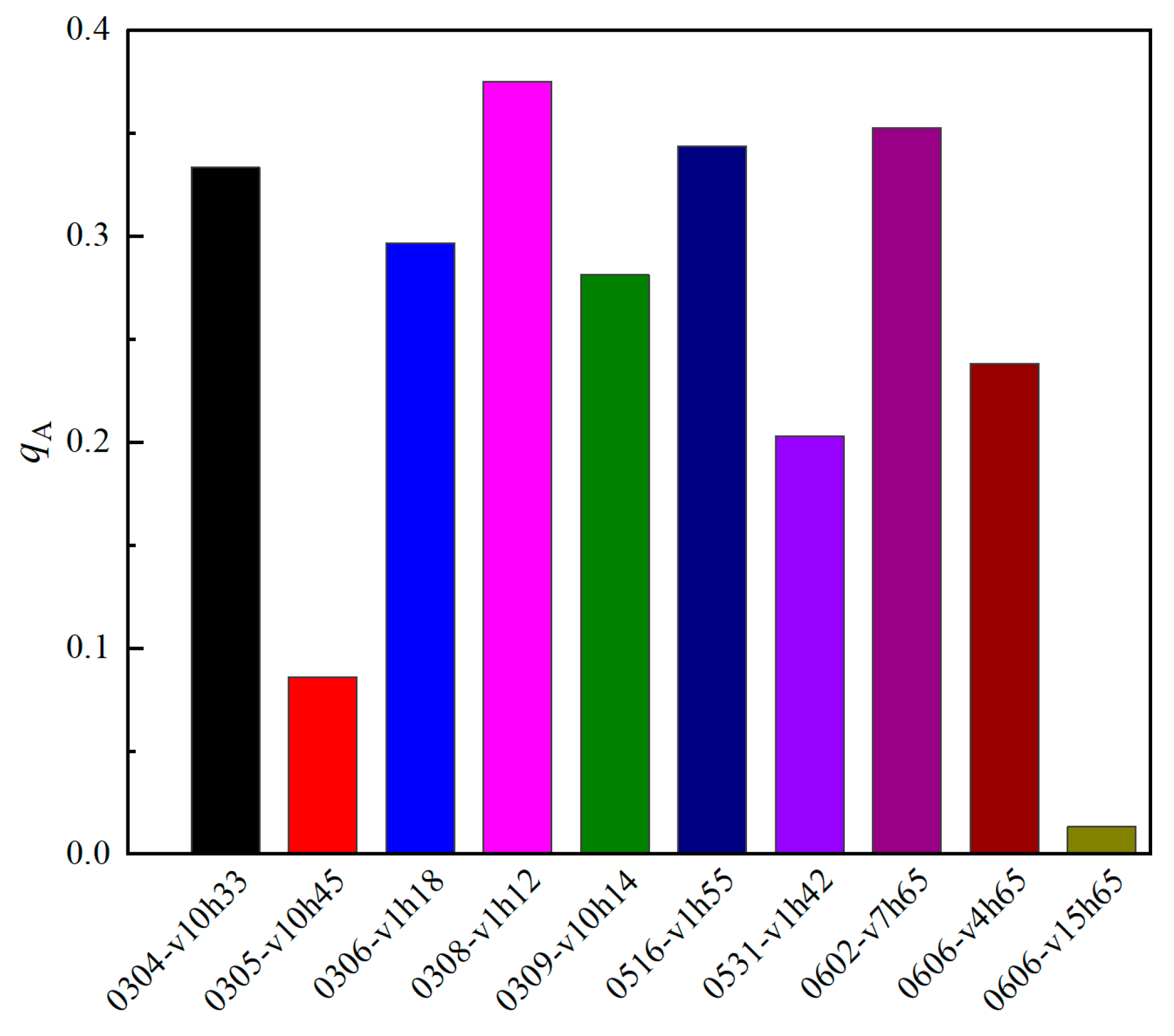
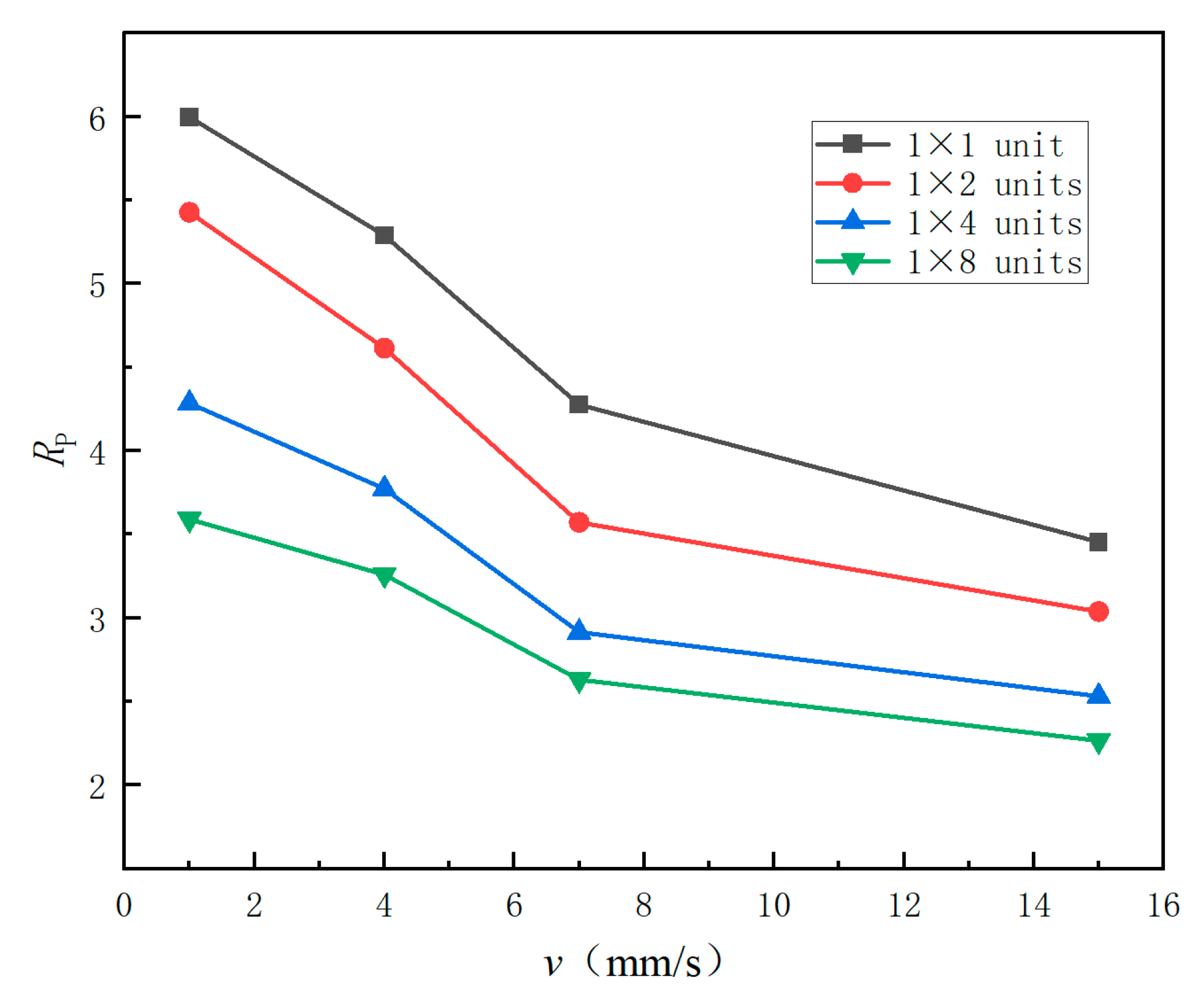
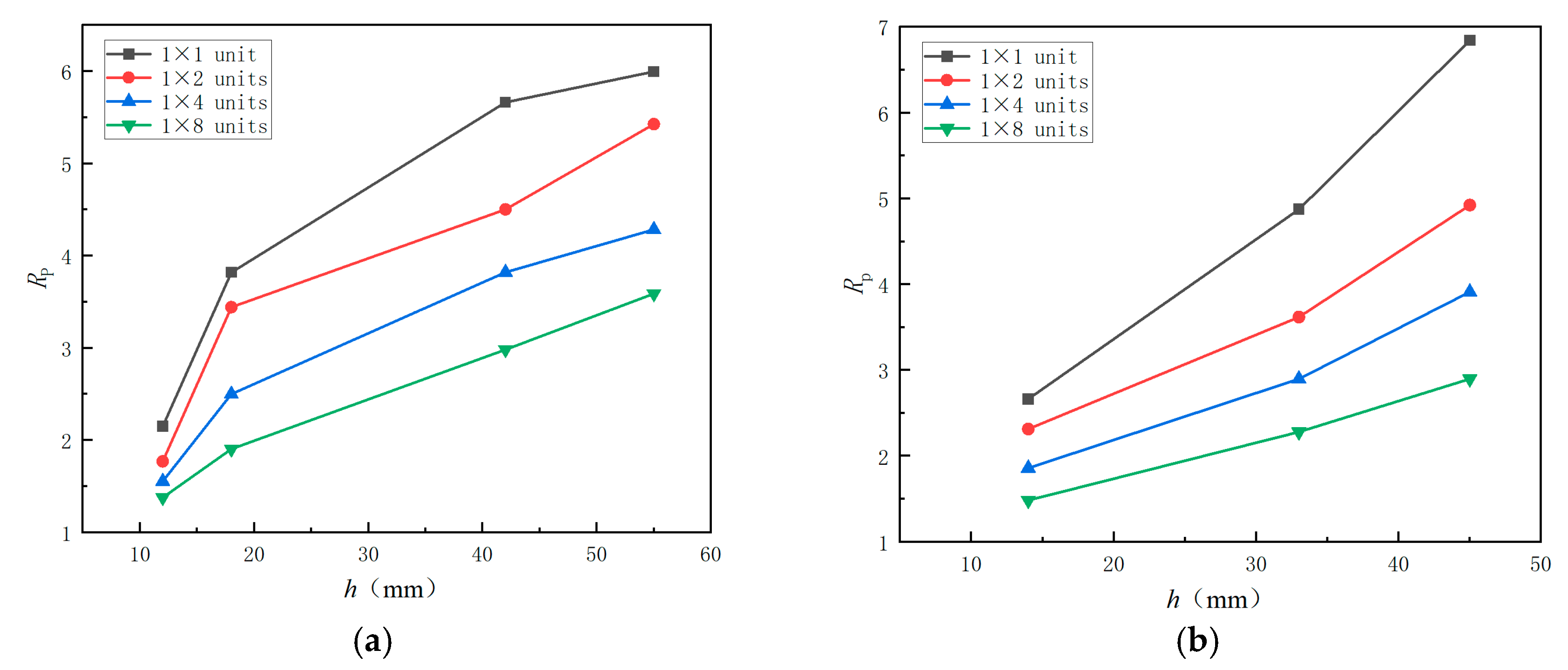

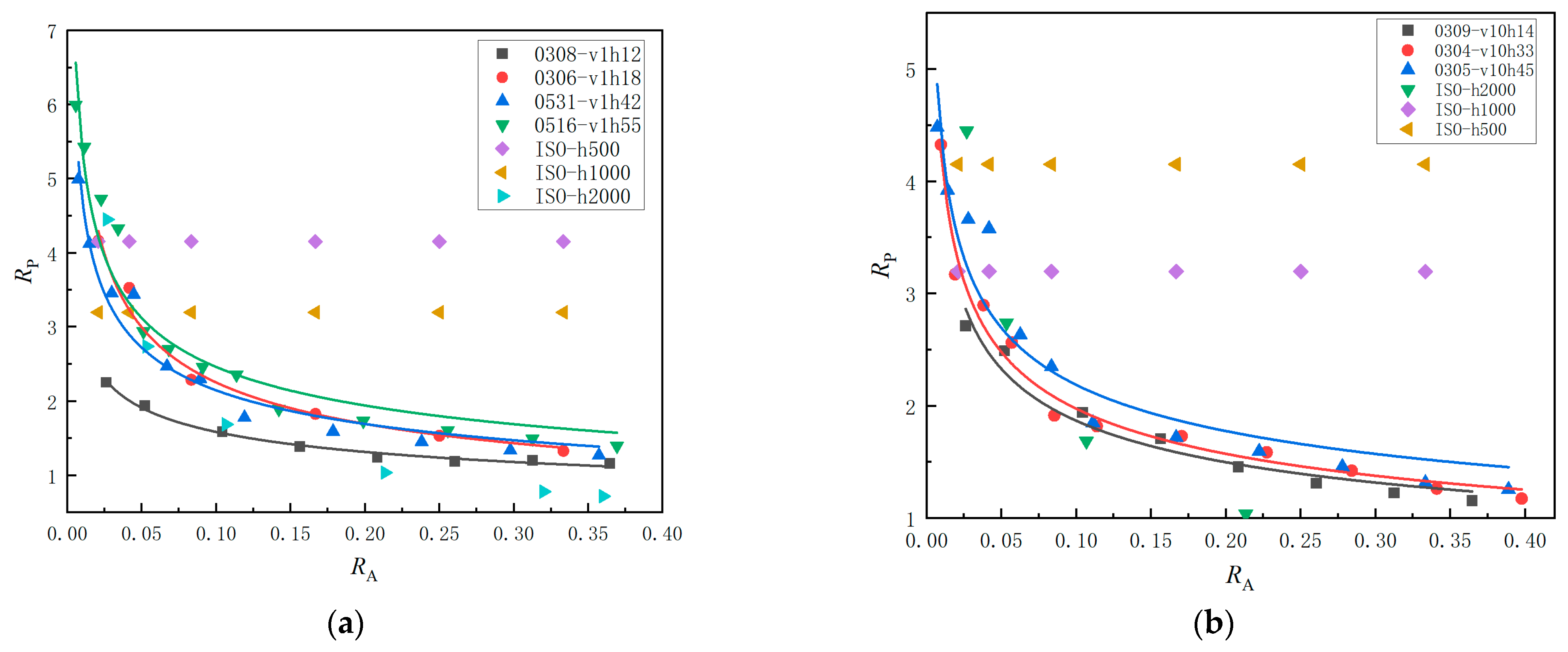

| Test Number | Start Time (s) | End Time (s) | Ice Sheet Thickness (mm) | Loading Speed (mm/s) |
|---|---|---|---|---|
| 0304-v10h33 | 13 | 33 | 33 | 10 |
| 0305-v10h45 | 13 | 33 | 45 | 10 |
| 0306-v1h18 | 75 | 280 | 18 | 10 |
| 0308-v1h12 | 75 | 280 | 12 | 1 |
| 0309-v10h14 | 13 | 33 | 14 | 1 |
| 0516-v1h55 | 60 | 200 | 55 | 1 |
| 0531-v1h42 | 60 | 200 | 42 | 1 |
| 0602-v7h65 | 22 | 52 | 65 | 7 |
| 0606-v4h65 | 22 | 75 | 65 | 4 |
| 0606-v15h65 | 8 | 22 | 65 | 15 |
| Loading Speed (mm/s) | Loading Stage | Peak Time | Unloading Stage | |||
|---|---|---|---|---|---|---|
| Proportion | Number of Occurrences | Proportion | Number of Occurrences | Proportion | Number of Occurrences | |
| 1 | 52.9% | 9 | 47.1% | 8 | 0 | 0 |
| 4 | 45.5% | 10 | 40.9% | 9 | 13.6% | 3 |
| 7 | 30.0% | 6 | 65.0% | 13 | 5.0% | 1 |
| 10 | 16.7% | 3 | 33.3% | 6 | 50.0% | 9 |
| 15 | 46.2% | 6 | 23.1% | 3 | 30.8% | 4 |
| Loading Speed (mm/s) | Ice Thickness (mm²) | Coefficient k | Exponent α | R² |
|---|---|---|---|---|
| 1 | 12 | 0.854 | −0.269 | 0.99 |
| 18 | 0.874 | −0.411 | 0.98 | |
| 42 | 0.976 | −0.342 | 0.96 | |
| 55 | 1.120 | −0.342 | 0.94 | |
| 10 | 14 | 0.900 | −0.317 | 0.96 |
| 33 | 0.930 | −0.327 | 0.98 | |
| 45 | 1.097 | −0.300 | 0.92 |
| Loading Speed (mm/s) | Ice Thickness (mm²) | Coefficient k | Exponent α | R² |
|---|---|---|---|---|
| 1 | 12 | 0.854 | 0.711 | −0.341 |
| 18 | 0.874 | 1.078 | −0.341 | |
| 42 | 0.976 | 0.981 | −0.341 | |
| 55 | 1.120 | 1.124 | −0.341 | |
| 10 | 14 | 0.900 | 0.905 | −0.315 |
| 33 | 0.930 | 0.968 | −0.315 | |
| 45 | 1.097 | 1.039 | −0.315 |
Disclaimer/Publisher’s Note: The statements, opinions and data contained in all publications are solely those of the individual author(s) and contributor(s) and not of MDPI and/or the editor(s). MDPI and/or the editor(s) disclaim responsibility for any injury to people or property resulting from any ideas, methods, instructions or products referred to in the content. |
© 2024 by the authors. Licensee MDPI, Basel, Switzerland. This article is an open access article distributed under the terms and conditions of the Creative Commons Attribution (CC BY) license (https://creativecommons.org/licenses/by/4.0/).
Share and Cite
Xu, Y.; Zhang, D.; Wu, K.; Peng, X.; Jia, X.; Wang, G. Study on the Factors Influencing the Amplitude of Local Ice Pressure on Vertical Structures Based on Model Tests. J. Mar. Sci. Eng. 2024, 12, 1634. https://doi.org/10.3390/jmse12091634
Xu Y, Zhang D, Wu K, Peng X, Jia X, Wang G. Study on the Factors Influencing the Amplitude of Local Ice Pressure on Vertical Structures Based on Model Tests. Journal of Marine Science and Engineering. 2024; 12(9):1634. https://doi.org/10.3390/jmse12091634
Chicago/Turabian StyleXu, Ying, Dayong Zhang, Kuankuan Wu, Xin Peng, Xunxiang Jia, and Guojun Wang. 2024. "Study on the Factors Influencing the Amplitude of Local Ice Pressure on Vertical Structures Based on Model Tests" Journal of Marine Science and Engineering 12, no. 9: 1634. https://doi.org/10.3390/jmse12091634







